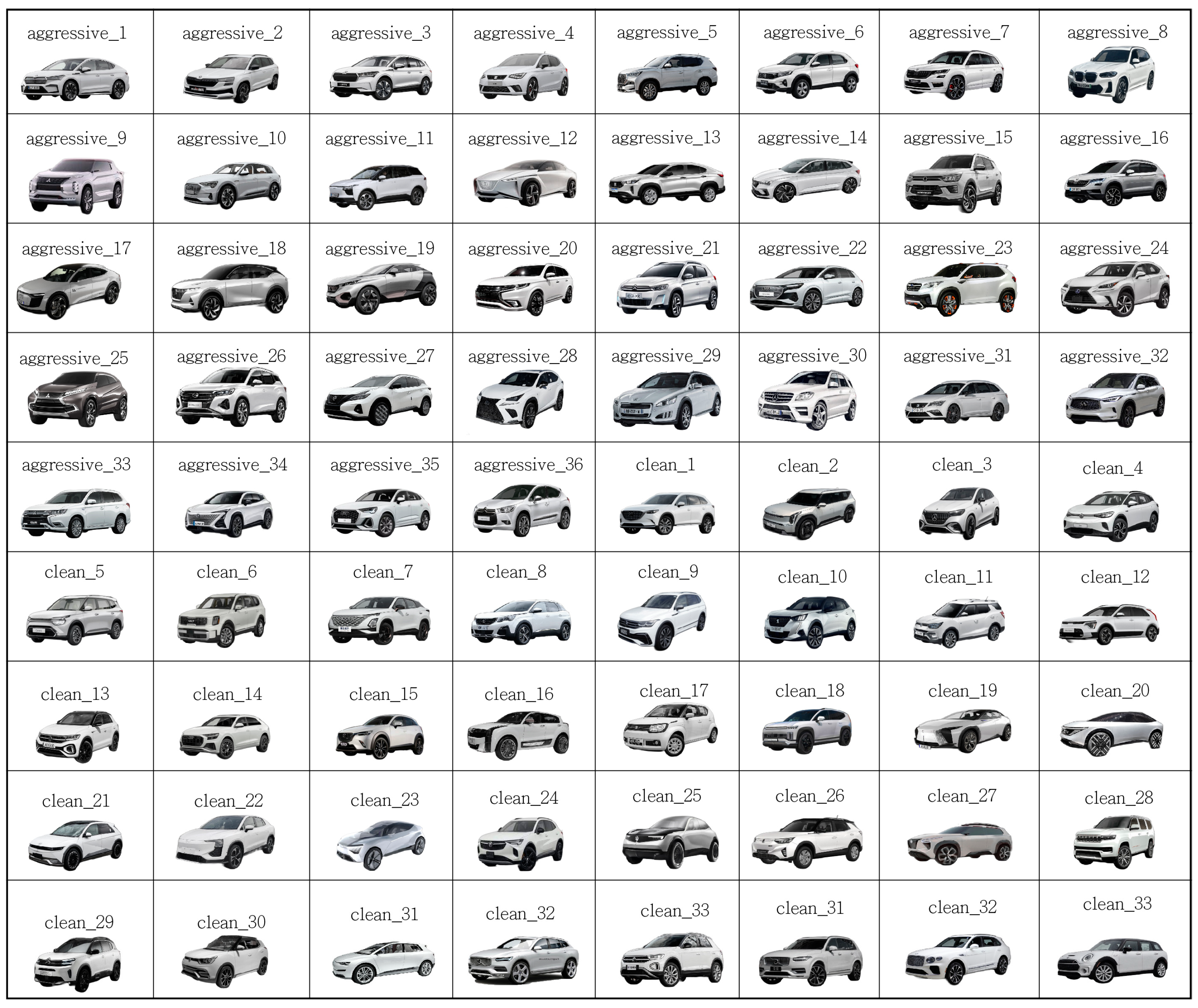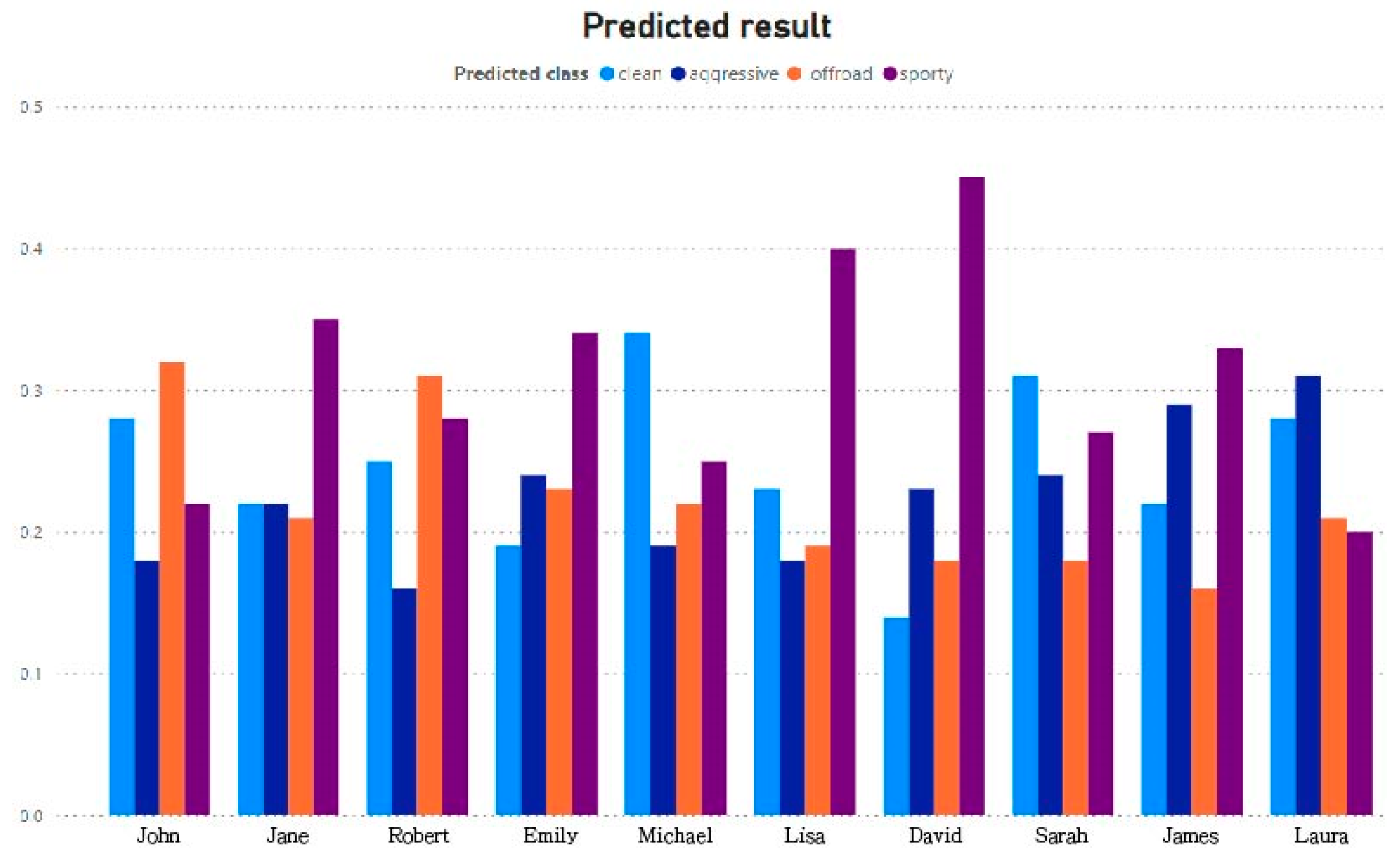Semantic Classification of Car Styling Using Machine Learning †
Abstract
1. Introduction
2. Related Work
2.1. Semantics of Automotive Styling
2.2. Semantics in Automotive Design Education
2.3. Image Classification Using Machine Learning
3. Methods
3.1. Data Collection
3.2. Data Preprocessing
3.3. Feature Extraction
3.4. Verification and Testing
3.5. Application and Evaluation
3.5.1. Model Categorization
3.5.2. Strengths and Weaknesses of WEKA Model
- Participation and cognitive reflection
- 2.
- Consistency
- 3.
- Inconsistency
- 4.
- Advantages of WEKA model
4. Conclusions
Author Contributions
Funding
Institutional Review Board Statement
Informed Consent Statement
Data Availability Statement
Acknowledgments
Conflicts of Interest
References
- Gartman, D. Auto-Opium: A Social History of American Automobile Design; Routledge: London, UK, 2013. [Google Scholar]
- Wang, H.-H.; Liu, C.-K.; Yu, S.-B. Predicting Consumer Preferences by the Deformation Threshold of Product Appearance. Eng. Proc. 2023, 55, 67. [Google Scholar] [CrossRef]
- Jankovic, R. Classifying cultural heritage images by using decision tree classifiers in WEKA. In Proceedings of the 1st International Workshop on Visual Pattern Extraction and Recognition for Cultural Heritage Understanding Co-Located with 15th Italian Research Conference on Digital Libraries (IRCDL 2019), Pisa, Italy, 30 January 2019; pp. 119–127. [Google Scholar]
- Kreuzbauer, R.; Malter, A.J. Embodied cognition and new product design: Changing product form to influence brand categorization. J. Prod. Innov. Manag. 2005, 22, 165–176. [Google Scholar] [CrossRef]
- Rubera, G. Design innovativeness and product sales’ evolution. Mark. Sci. 2015, 34, 98–115. [Google Scholar] [CrossRef]
- Aronoff, M. Automobile semantics. Linguist. Inq. 1981, 12, 329–347. [Google Scholar]
- Berry, J. Overcoming the complexity of teaching form and detail aesthetics in product design education. In Proceedings of the DS 46: Proceedings of E&PDE 2008, the 10th International Conference on Engineering and Product Design Education, Barcelona, Spain, 4–5 September 2008; pp. 156–161. [Google Scholar]
- Huang, C. Design for Ease of Use: Product Semantics and Design Education. Doctoral Dissertation, Manchester Metropolitan University, Manchester, UK, 1996. [Google Scholar]
- Burnap, A.; Hauser, J.R.; Timoshenko, A. Product aesthetic design: A machine learning augmentation. Mark. Sci. 2023, 42, 1029–1056. [Google Scholar] [CrossRef]
- Wang, H.-H.; Lin, Y.-Y.; Huang, H.-T. Application of Typicality in Predicting Product Appearance. Eng. Proc. 2023, 55, 66. [Google Scholar] [CrossRef]
- Wang, H.H.; Chen, C.P. STYRULE-A Classification System of Car Styling. J. Des. 2009, 9, 107–121. [Google Scholar]
- Ma, L.; Wu, Y.; Li, Q.; Yuan, X. Recognition of car front facing style for machine-learning data annotation: A quantitative approach. Symmetry 2022, 14, 1181. [Google Scholar] [CrossRef]
- Car Body Design. Available online: https://www.carbodydesign.com/ (accessed on 1 May 2024).
- Car Design News. Available online: https://www.cardesignnews.com/ (accessed on 1 May 2024).




| Student | Aggressive | Clean | Off-Road | Sporty |
|---|---|---|---|---|
| John | 0.18 | 0.28 | 0.32 | 0.22 |
| Jane | 0.22 | 0.22 | 0.21 | 0.35 |
| Robert | 0.16 | 0.25 | 0.31 | 0.28 |
| Emily | 0.24 | 0.19 | 0.23 | 0.34 |
| Michael | 0.19 | 0.34 | 0.22 | 0.25 |
| Lisa | 0.18 | 0.23 | 0.19 | 0.40 |
| David | 0.23 | 0.14 | 0.18 | 0.45 |
| Sarah | 0.24 | 0.31 | 0.18 | 0.27 |
| James | 0.29 | 0.22 | 0.16 | 0.33 |
| Laura | 0.31 | 0.28 | 0.21 | 0.20 |
Disclaimer/Publisher’s Note: The statements, opinions and data contained in all publications are solely those of the individual author(s) and contributor(s) and not of MDPI and/or the editor(s). MDPI and/or the editor(s) disclaim responsibility for any injury to people or property resulting from any ideas, methods, instructions or products referred to in the content. |
© 2025 by the authors. Licensee MDPI, Basel, Switzerland. This article is an open access article distributed under the terms and conditions of the Creative Commons Attribution (CC BY) license (https://creativecommons.org/licenses/by/4.0/).
Share and Cite
Wang, H.-H.; Lu, Y.-T. Semantic Classification of Car Styling Using Machine Learning. Eng. Proc. 2025, 89, 13. https://doi.org/10.3390/engproc2025089013
Wang H-H, Lu Y-T. Semantic Classification of Car Styling Using Machine Learning. Engineering Proceedings. 2025; 89(1):13. https://doi.org/10.3390/engproc2025089013
Chicago/Turabian StyleWang, Hung-Hsiang, and Yen-Ting Lu. 2025. "Semantic Classification of Car Styling Using Machine Learning" Engineering Proceedings 89, no. 1: 13. https://doi.org/10.3390/engproc2025089013
APA StyleWang, H.-H., & Lu, Y.-T. (2025). Semantic Classification of Car Styling Using Machine Learning. Engineering Proceedings, 89(1), 13. https://doi.org/10.3390/engproc2025089013







